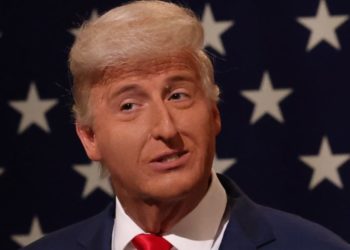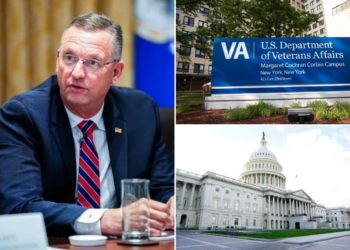Tariffs are at their highest rates in decades. Hundreds of thousands of federal workers are going without paychecks. Artificial intelligence is threatening to reshape the American work force.
The effect all of that is having on the U.S. economy at the moment is impossible to know.
The United States is a month into a government shutdown that has hobbled the nation’s statistical agencies and created the longest economic data blackout in history. The normally steady flow of government data on hiring, spending, wages, prices and other areas has slowed to a trickle, leaving economists to try to fill in the gaps using anecdotes and a mélange of incomplete and often contradictory indicators from private sources.
There is no good time to go without reliable data. But this might be a uniquely bad one. Job growth slowed sharply over the summer, leading to fears that the labor market could be taking a rapid turn for the worse. Such a development would most likely draw a swift response from officials at the Federal Reserve, who are responsible for maximizing employment while keeping inflation stable. But policymakers have no reliable way of knowing whether those trends continued into the fall, or perhaps reversed.
Tara Sinclair, an economist at George Washington University, likened the situation to driving down a road in a heavy fog.
“Until something comes along in front of you, or until the road curves, you might be OK,” she said. “But at some point, there will be something in front of you, or the road will curve, and we don’t know when that will be.”
Jerome H. Powell, the Fed chair, used the same analogy on Wednesday, acknowledging that the lack of data is exacerbating an already difficult situation for policymakers who are weighing the risk of a softening labor market against still-stubborn inflation. The central bank lowered interest rates on Wednesday by a quarter point for the second time this year. But in a sign of the deep divisions on the committee, two officials dissented in opposite directions — one calling for a larger cut, and one for no cut at all.
Even before the data went dark, President Trump’s ever-changing policies on trade and immigration were making it hard for forecasters to figure out where the economy was headed and for policymakers to agree on the best way to respond. The shutdown has introduced yet another source of economic upheaval, especially as it drags on with little end in sight. Many federal workers missed their first full paycheck this week, and 42 million people are at risk of losing nutrition benefits beginning Saturday.
Against this backdrop, Mr. Powell on Wednesday cast doubt on the possibility of another interest rate cut at the Fed’s final meeting of the year in December. He said it was “far from” a foregone conclusion given that there were “strongly differing views” about how to proceed. Mr. Powell also emphasized that the lapse in data related to the shutdown could in theory encourage the Fed to stand pat.
“If there is a very high level of uncertainty, then that could be an argument in favor of caution about moving,” he said at a news conference after the Fed’s two-day policy meeting.
Before that meeting, policymakers caught a lucky break. Last week, the Bureau of Labor Statistics released inflation data for September because it was needed to calculate the annual cost-of-living adjustment for Social Security benefits.
But the fog will get thicker from here. The statistical agency was able to release the September inflation report because the underlying data had been collected before the government shut down on Oct. 1. But it hasn’t collected any new data since then. The White House said last week that the government might not be able to release an October inflation report at all. Reports on the job market, consumer spending, manufacturing and other topics are also in jeopardy.
“We will forever have a question mark about what’s going on right now,” said Karen Dynan, a Harvard economist who was a senior official at the Treasury Department under President Barack Obama. “We can’t go back and recreate accurate estimates.”
Even when the government reopens, it will take time to restart the data engine. That means that when Fed officials gather for their next meeting, on Dec. 9-10, they may have little more information on the state of the economy than they did this week.
It isn’t just the Fed that is being left in the dark. Corporate executives are trying to forecast their sales as they decide where and whether to expand their businesses. Investors are trying to assess the impact of tariffs, artificial intelligence and other forces on corporate profits and government revenues. State and local officials are trying to figure out how the shutdown is affecting their local economies.
Imperfect Alternatives
In the absence of official statistics, economists are turning to data from the private sector. Those sources have multiplied in recent years, particularly after the coronavirus pandemic led to a surge in demand for new economic measures.
Economists say those sources can be valuable, providing data that is more timely or more granular than what the government can offer. But they leave large gaps. For example, there is hardly any reliable private-sector data on the price of services — a broad category that includes medical procedures, haircuts and interior decorating. And no private source could even begin to provide an estimate of a comprehensive measure like gross domestic product, which attempts to capture the value of all goods and services produced in the country.
“It gets us part of the way, but it doesn’t tell us what policymakers and businesses need to know,” said Jed Kolko, who oversaw economic data at the Commerce Department during the Biden administration. “And the longer we lack official statistics, the greater the risk that private-sector data starts pointing the wrong direction.”
Even in areas where private data is more widely available, like consumer spending and the labor market, the sources are a supplement to government statistics, not a replacement. Most private data series have been around for only a few years, not the decades covered by government sources. And even the largest private companies lack a comprehensive view of the U.S. economy.
That is a particular problem right now, when Mr. Trump’s policies are affecting different regions, industries and demographic groups in different ways. A retailer that sells primarily to lower-income Hispanic customers will have a starkly different view of the economy right now than one that targets more affluent consumers.
Perhaps as a result, different sources are telling conflicting stories about the health of the economy. The Johnson Redbook Index, a longstanding measure of same-store retail sales, suggests that consumer spending continued to grow at a healthy rate this fall. But a measure of debit card transactions published by Bloomberg shows a more worrying slowdown.
Similarly, ADP, the payroll processor, reported that private employers cut jobs in September, although a new weekly series from the company shows a modest rebound in early October. But other sources, including one from Revelio Labs, a labor market data company, suggest that hiring has cooled but not stopped. States have also continued to release data on applications for unemployment benefits, which have risen only modestly.
“We have gotten private-sector data that suggest the labor market is slowing down, that suggest the labor market is slowing down in a worrying way, and that suggest that the labor market might really be in trouble,” said Martha Gimbel, executive director of the Budget Lab at Yale. “I don’t know which one of those is right.”
At a Tipping Point?
The conflicting signals are particularly concerning for economists because, historically, when the labor market has deteriorated, it has often done so quickly. In 2008, for example, the unemployment rate held mostly steady in the spring, then rose rapidly to 6.1 percent in August from 5 percent in April. If a similar spiral were to happen now, policymakers might not know until it was too late to prevent significant damage.
“The economy turns, and you can’t tell it’s turning by just looking out your window,” Ms. Dynan said. “I don’t think it’s impossible that when the data tap is turned back on, we’ll see something happened in the economy that would have warranted a serious policy response.”
Some economists argued that policymakers would be able to pick up on a drastic downturn in the labor market even without government data. But a more subtle shift could be harder to detect. What makes the situation all the more difficult is that Mr. Trump’s immigration crackdown has pushed foreign-born workers out of the labor force — or out of the country entirely — and discouraged new people from entering the country. The resulting decline in the growth of the labor force has made it hard to know what a healthy pace of monthly jobs growth now looks like.
“I don’t think a really bad economy can hide,” said Wendy Edelberg, an economist at the Brookings Institution. “I do think that an economy that’s turning bad can hide.”
Mr. Powell echoed that point on Wednesday, saying that “if there were a significant or material change in the economy one way or another, I think we would pick that up through this.”
But having a partial view of the economy at a highly uncertain moment increases the risk that the Fed will make a mistake, either by cutting interest rates too quickly and allowing inflation to pick back up or by moving too slowly, resulting in rising unemployment. Mr. Powell suggested that officials had different views about which mistake was more costly, helping to explain why divisions have sharpened about what to do next.
“The division is going to get a lot worse,” said David Seif, chief economist for developed markets at Nomura. He noted that in September, a sizable group of Fed officials had already indicated they would not want to cut interest rates again this year.
Authoritative data might have helped resolve the dispute, said Anil Kashyap, a University of Chicago economist who has served as an adviser to central banks in several countries. Without it, policymakers are more likely to trust the sources that support their existing positions, he said.
“If you’ve got a divided committee where there’s differences of opinion, often the data is kind of the tiebreaker,” Mr. Kashyap said.
But the Fed may not have that luxury. Mr. Powell said on Wednesday that he hoped to have the relevant data in hand by the December meeting, but lawmakers do not appear close to a deal to fund the government.
“What do you do if you’re driving in the fog?” Mr. Powell asked rhetorically. “You slow down.”
Ben Casselman is the chief economics correspondent for The Times. He has reported on the economy for nearly 20 years.
Colby Smith covers the Federal Reserve and the U.S. economy for The Times.
The post A Month Without Data Muddles the Economic Picture appeared first on New York Times.




